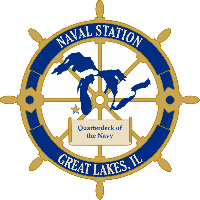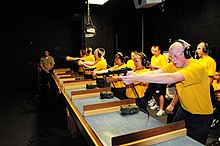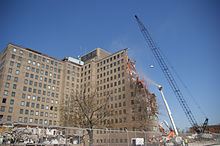Great Lakes, IL
Featured Community Listings
best real estate agent Great Lakes IL
If you are looking for one of the best real estate agent great lakes IL, look no further.
| Naval Station Great Lakes | |
|---|---|
| Part of Navy Region Mid-Atlantic | |
| North Chicago, Illinois, U.S. | |

Naval Station Great Lakes insignia
|
|
|
Location in Illinois
|
|
| Coordinates | 42°18′33.08″N 87°51′0.25″WCoordinates: 42°18′33.08″N 87°51′0.25″W |
| Site information | |
| Owner | |
| Controlled by | |
| Site history | |
| In use | 1911–present |
| Garrison information | |
| Past commanders |
Captain William Bulis, USN |
| Garrison | Recruit Training Command |
|
Great Lakes Naval Training Station
|
|

Great Lakes Building 1
|
|
| Nearest city | Waukegan, Illinois, U.S. |
| Area | 193.2 acres (78.2 ha) |
| Built | 1906 |
| Architect | Jarvis Hunt, Et al. |
| Architectural style | Classical Revival, Federal Revival |
| NRHP reference No. | 86002890[1] |
| Added to NRHP | September 15, 1986 |
Naval Station Great Lakes (NAVSTA Great Lakes) is the home of the United States Navy‘s only boot camp, located near North Chicago, in Lake County, Illinois. Important tenant commands include the Recruit Training Command, Training Support Center and Navy Recruiting District Chicago. Naval Station Great Lakes is the largest military installation in Illinois and the largest training station in the Navy. The base has 1,153 buildings situated on 1,628 acres (6.59 km2) and has 69 miles (111 km) of roadway to provide access to the base’s facilities. Within the naval service, it has several different nicknames, including “The Quarterdeck of the Navy”,[2] or the more derogatory “Great Mistakes”.[3]
The original 39 buildings built between 1905 and 1911 were designed by Jarvis Hunt.[4]
The base is like a small city, with its own fire department, Naval Security Forces (Police), and public works department.
If you’re looking for one of the best real estate agent Great Lakes IL, click here.
One of the landmarks of the area is Building 1, also known as the clocktower building. Completed in 1911, the building is made of red brick, and has a tower over the third floor of the building. The large parade ground in front of the administration building is named Ross Field.
best real estate agent Great Lakes IL
Recruit Training Command
In 1996, RTC Great Lakes became the Navy’s only basic training facility. The Base Realignment and Closure Commission of 1993 resulted in the closure of Naval Training Center San Diego, California and Naval Training Center Orlando, Florida, their associated Recruit Training Commands, and the consolidation of US Navy enlisted recruit training to Great Lakes. Approximately 40,000 recruits pass through Recruit Training Command annually with an estimated 7,000 recruits on board the installation at any time. RTC Great Lakes has been active for over 100 years.
best real estate agent Great Lakes IL
TSC Great Lakes is the Navy’s premier technical training command. It has an annual throughput of 16,000 Sailors a year. TSC supports the following six learning sites:
- Center for Surface Combat Systems (CSCS)
- Surface Warfare Officers School Command Unit (SWOSU)
- Center for EOD and Dive (CNEODD)
- Center for Naval Leadership (CNL)
- Center for Personal Development (CPD)
- Center for Service Support (CSS)
Navy Junior ROTC cadets from Hamilton High School, Ohio, practice marksmanship at the Fire Arms Training Simulator (FATS)
The following rating training class A-schools are located at Naval Station Great Lakes:
- Electrician’s Mate (EM)
- Electronics Technician (ET)
- Fire Controlman (FC)
- Gunner’s Mate (GM)
- Interior Communications Electrician (IC)
- Boatswain’s Mate (BM)
- Operations Specialist (OS)
- Hull Maintenance Technician (HT)
- Damage Controlman (DC)
- Engineman (EN)
- Gas Turbine System Technician (Electrical) (GSE)
- Gas Turbine System Technician (Mechanical) (GSM)
- Machinery Repairman (MR)
- Quartermaster (QM)
- Machinist Mate (MM)
Culinary Specialist (CS) A-school was also taught at TSC Great Lakes until December 10, 2010, when the school graduated its final class. The course has been consolidated with the US Army’s parallel program and relocated to Fort Lee, Virginia.
Hospital Corpsman (HM) “A” School has been moved out of Great Lakes. The last class graduated on July 27, 2011. Its last class was Class 11-125. The school has relocated to the Medical Education and Training Campus at Fort Sam Houston, Joint Base San Antonio, Texas.[5] This change has merged Air Force, Army, and Navy Medical staff to a centralized location.
In addition, all Navy rates that require basic electrical knowledge and troubleshooting training complete Apprentice Technical Training (ATT) school. This includes the Mineman (MN) and Sonar Technician (Surface) (STG) rates, as well as some aviation rates prior to detachment to their respective school locations in San Diego, CA and Pensacola, Florida. Boatswain’s Mates complete Surface Common Core (SCC) Basic Maintenance Training and engineering rates complete Basic Engineering Common Core (BECC)
History
Great Lakes was approved in 1904 by Theodore Roosevelt.[6] Construction was supervised by Navy Captain Albert R. Ross. Chicago-area architect Jarvis Hunt designed the original 39 buildings and Lt. George A. McKay was the civil engineer for the construction on the 172 acres (70 ha) wilderness location;[7] $3.5 million ($99.6 million today) was appropriated to finance construction. President William Howard Taft dedicated the Naval Training Station in 1911.[8] On 3 July 1911, Joseph Gregg was the first recruit to arrive. He would graduate in the first class of 300. Fifty-five years later, he was buried at the Naval Station Cemetery 5 July 1966.[7][9]
Legendary band leader and march composer John Philip Sousa was commissioned as a lieutenant in the Navy during World War I. He led the Great Lakes Naval Station Band from mid-1917 until shortly after the Armistice was implemented in November 1918. Great Lakes also had a Radio School including two 400 feet (120 m) towers constructed in 1915.[8] From 1911 to 1916 around 2,000 recruits a year were trained at Great Lakes.[7]
World War I
At the start of 1917, just prior to the United States entry to World War I, Great Lakes was under the command of Captain William A. Moffett and had 39 permanent brick buildings, over 165 acres (67 ha), and about 1,500 Sailors. At the close of the war, there were 776 buildings, with 1,200 acres (490 ha) and about 45,000 Sailors in training; 125,000 had been trained at Great Lakes during the war.[7]
best real estate agent Great Lakes
In 1923, Naval Reserve Air Base, Great Lakes was commissioned. Recruit training slowed after the war and halted in 1933.[7] In 1932, Great Lakes had 102 buildings on 507 acres (205 ha). A port was constructed around that time at a cost of $1 million ($18.7 million today).[8]
On 1 July 1933, Great Lakes was closed and placed in a maintenance status.[10] It was reopened 1 July 1935 after lobbying by local businessmen and the Congressional Delegation from Illinois.[8] In 1936, aviation training was moved from Great Lakes to Naval Air Station Glenview.[7]
On 9 December 1940, the Class A Service School opened for its first class.[7]
World War II
On 7 December 1941, Pearl Harbor was attacked by Japan, and around 6,000 sailors were training at Great Lakes. This grew to 68,000 in six months; by September 1942, over 100,000 Sailors were training at Great Lakes. The base grew to 1,600 acres (650 ha) in the next 10 months. By mid-1943, there were over 700 instructors at the Class A service schools.[7]
The Navy selected Great Lakes to be the site of the first African American trainees. On 5 June 1942, Doreston Luke Carmen of Galveston, Texas was the first recruit to enter the segregated training facility at Camp Robert Smalls. In September 1942, segregated “Negro Service Schools” were opened. The policy of segregation led to small service school classes with only four or five students in a class. By 1944 Great Lakes began to integrate training and all training was integrated by mid-1945. The Golden Thirteen were commissioned in March 1944 after training at Great Lakes.[7]
Four million served on active duty in the Navy during World War II. Over one million Sailors were trained at Great Lakes.[7]
1946 to 1960
Modernist glass and steel US Navy Gunnery school, Great Lakes. Designed by Skidmore, Owings & Merrill, dedicated in 1954, demolished 2012.
In 1948, a boot camp for WAVES (female recruits) opened at Great Lakes, first graduating 5 October 1948. In 1951, female recruit training left Great Lakes for United States Naval Training Center, Bainbridge, Maryland best real estate agent Great Lakes.
Great Lakes hosted the Commander, Ninth Naval District from 1945 until the District was disestablished on 30 June 1979. best real estate agent Great Lakes
In March 1954, new facilities at Great Lakes for training Gunner’s Mates, Fire Controlman, Opticalman, and Instrumentman were dedicated, at a cost of $2.2 million ($20.9 million today). At the time, the 95,000 square feet (8,800 m2) Gunnery School was said to be the largest all glass structure in the world.[7] Designed by Bruce Graham (co-designer of the former Sears Tower and John Hancock Center) of the Chicago office of Skidmore, Owings & Merrill, the Gunnery School was demolished in 2012 after hands-on training transitioned to computer-based training in 2005. In 2008, an attempt was made to preserve the structure that was described as a “Cathedral of the Cold War”.[11][12][13]
Starting in the late 1950s, new barracks, mess halls, classrooms, and staff offices at the Recruit Training Center were built for around $8 million. best real estate agent Great Lakes These facilities served the Navy until the late 1990s rebuild of the recruit training facility.[7]
1960s and 1970s[edit]
On 9 December 1960, Great Lakes Naval Hospital (building 200H) was dedicated replacing the original hospital, building 1H. During the Vietnam War, the hospital cared for over 11,000 patients at the 478,000 square feet (44,400 m2), 825 bed facility.[14] Demolition of the hospital began in January 2013 after its services were transitioned to the Captain James A. Lovell Federal Health Care Center in 2010.[14][15][16]
In August 1965, facilities at Great Lakes were used as a morgue in the aftermath of the crash of United Airlines Flight 389.[17]
In the early morning hours of 11 March 1967, Rear Admiral Howard A. Yeager, Commander, 9th Naval District, was killed by a fire at his quarters at Great Lakes. Admiral Yeager and two hospital corpsman (WAVES) died attempting to save the Admiral’s wife, who was under medical care for multiple sclerosis. She also died several days later.[7][18]
On 28 September 1972, 18 were injured at Great Lakes when a tornado struck two of the base housing areas. best real estate agent Great Lakes
In 1979, there were some instances of violence between sailors at Great Lakes and civilians of North Chicago. In June 1979, more than 300 Sailors armed with bricks and rocks rioted in North Chicago for at least two consecutive nights in protest after a group of civilians infiltrated the base and beat a Sailor. Two hundred Sailors were said to have climbed the fence, entering North Chicago and clashing with local police. Sixteen persons were arrested, with five injuries on the first night. Five were arrested by police, with 16 in custody of Navy authorities on the second night. best real estate agent Great Lakes IL Additionally, six Sailors and five police officers were injured on the second night of riots and a police cruiser was overturned. Sailors claimed unfair treatment and harassment in the North Chicago entertainment district known as the “strip”.[20][21] Local officials disputed the claims. The six-block entertainment district or “strip” was eventually placed off limits indefinitely by the base commander.[22]
In the aftermath of the rioting, 58 summary courts-martial were conducted, 19 Sailors were found not-guilty, and the base commander Captain Robert D. Colvin was replaced by Rear Admiral Thomas L. Malone Jr.[23][24]
Days after the riots on 28 June 1979, four black males were sought in connection with the robbery of the Great Lakes Naval Station branch of the Citizens Bank of Waukegan. Around $125,000 ($440 thousand today) was stolen. The bank manager was abducted from his home in Zion and was held captive along with several others until the automatic lock of the bank vault allowed it to be opened the next morning. No one was harmed in the robbery.[25] Payday for the base was set for the following day. best real estate agent Great Lakes IL
(Sourced by Wikipedia)




